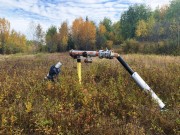The oil and gas industry has seen dramatic transformations since 2004, when the Pembina Institute published the second edition of “When the Oilpatch Comes to Your Backyard.” The industry and its related services have almost tripled in size, there is a new energy regulator, and new extraction methods have changed Albertans’ relationship with their oil and gas neighbours.
 Because of this, it is more important than ever to release a third edition, known as the Landowners’ Guide to Oil and Gas Development. We’ve created this guide specifically to level the playing field and provide a balanced and objective guide for landowners, nearby residents, and others who have a lot of questions when a new oil and gas neighbour moves in. We’ve heard from people who say they don't feel they have the information they need when it comes time to negotiate. They also don’t know the important questions to ask when they are consulted on a nearby project proposal. This guide is primarily meant to provide advice for them when they sit down with or try to get the attention of people who live and breathe this subject matter every day.
Because of this, it is more important than ever to release a third edition, known as the Landowners’ Guide to Oil and Gas Development. We’ve created this guide specifically to level the playing field and provide a balanced and objective guide for landowners, nearby residents, and others who have a lot of questions when a new oil and gas neighbour moves in. We’ve heard from people who say they don't feel they have the information they need when it comes time to negotiate. They also don’t know the important questions to ask when they are consulted on a nearby project proposal. This guide is primarily meant to provide advice for them when they sit down with or try to get the attention of people who live and breathe this subject matter every day.
New types of O&G development
Multistage hydraulic fracturing and other new oil and gas technologies have transformed what it means to have the patch in the neighbourhood. Even for landowners who’ve had a well or pipeline on their land for decades, the new face of oil is quite different. New operations are more intensive and more disruptive. Operations, on-site equipment and traffic have increased and activity can remain high for months on end. Development now includes multiple wells on much larger pads where fracturing fluids are injected into the underlying geology in order to create underground cracks that allow access to previously inaccessible tight oil and shale gas. After the fracturing, these fluids return to the surface and require more effort to store, treat and dispose of. The operations now require enormous quantities of water and other fluids that must be trucked on country roads.
New Regulator, New Rules
The Alberta Energy Regulator (AER) is now the “one-stop shop” for energy resource development in Alberta. When it comes to environment, water and public land use approvals for oil and gas development, the AER takes on the responsibilities of the Energy Resources Conservation Board and Ministry of Environment and Parks. This changes how people affected by oil and gas development interact with the government. In some ways it’s simpler. For example, landowners don’t have to engage multiple government bodies to get information or to raise their concerns. However, in other ways the legislation that created the AER limited opportunities for landowners to voice their concerns and gives fewer rights to a hearing. This means projects are approved more quickly and there are fewer ways for anyone to argue the AER’s decisions.
Leaving Your Backyard
Accompanying all this change is the unprecedented rise in abandoned and orphaned wells in Alberta. With extremely low oil and gas prices there has also been an increase in the number of orphan wells – wells whose “owner” has ceased to exist and are for all practical purposes nobody’s responsibility. As of October, there were 1,360 orphan wells licensed to defunct companies waiting to be abandoned by the orphan well association. With the potential for even more orphaned wells while oil prices remain low, landowners are concerned about who is going to clean up the mess on their property.
New Guide for all the changes
For people who already have daily concerns to deal with, like feeding the cattle, harvesting before the frost, and balancing the books, the maze of regulations and potential problems can leave them feeling overwhelmed. Pembina’s new landowners’ guide provides all parties with access to a common body of information about citizens’ rights in Alberta as they relate to oil and gas development. It summarizes each stage in oil and gas development (from seismic exploration to land reclamation) and informs landowners about their surface rights and what questions to ask before signing a lease or right-of-entry agreement. It describes the types of technologies or operations that may be developed near you and guides you to ask the right questions.
To make this resource as accessible as possible, our guide is available to download for free from our website or, if you prefer a hard copy, you can order the guide as a bound book from the Pembina Institute.








